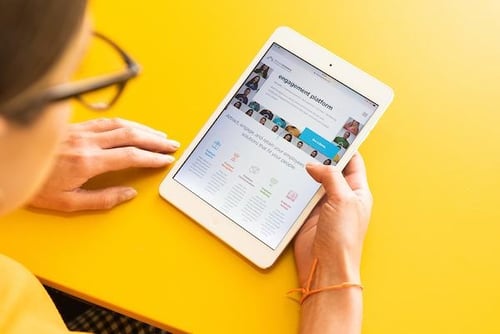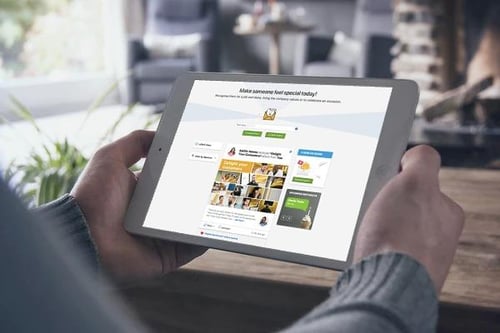
5 min read
Social media is like annoying infomercials and taxes these days – there is just no avoiding it. While we once used our Nokia 3210s (R.I.P little brick) to phone and text each other, today we’re connected through our social accounts instead.
Using them has become integrated in our daily habits of sharing and communication. We don’t need to ask our friends how their holiday was; we saw photos and videos in real time.
Social channels are bridging distances between people and changing the way we communicate. And they’re reaching all demographics.
My Dad recently joined Facebook, and my 2-year-old niece learned how to fire up Peppa Pig on YouTube before she could talk.
Incredibly smart algorithms and intuitive systems mean that our feeds know us better than some of our friends. As a result, places like Facebook, Instagram, LinkedIn and Twitter can give us exactly what we want, when we want it and how we want it. It’s no wonder we’re all so drawn to them.
This means that we’re developing more personal relationships with brands than ever before. In the past, our messenger services or photograph feeds may have been regarded as personal. Fast forward to now, and our feeds are populated with various brands that communicate in a friendly, relatable way.
Meaning, communicating authentically and effectively with audiences is the goal. The question is, then, how can employees replicate this when it comes to improving connections with employers?
Learning from the success of social communication
Of course, as with everything, each channel has its weaknesses alongside its strengths. While it once seemed like everyone was on Facebook (dads included), recently it feels that chunks are leaving, thanks to a particularly bad bout of recent PR.
While Twitter can be great for networking, or finding an expert on a particular topic, it can feel very noisy. Personally, I don’t trust Twitter to get my message out, and find the word count restrictive.
As for Instagram, our pre-scheduled images never get as much traction as fresh snaps of what the company is doing live, that day. The user is seeking authenticity above all else.
Social media isn’t only smart in terms of its ability to replicate familiarity. It has also begun teaching us a new way to communicate, without us even realising that we’re learning.
Thanks to social media, we use abbreviations more than ever before and express our emotions not with descriptive words, but through emojis. Thanks to comment sections we increasingly feel that permission is auto-granted to tell the world what we think and how we feel. We are increasingly used to being able to join in.
You could even use employer-branded emojis. For example, a liquor company might have the cheersing of two champagne glasses to symbolise "agree" and an empty pint glass for "disagree."

Replicating the success of social with employee engagement technology
If you’re going to connect with all of these generations (as my Dad and niece have proved, it really is all generations), you’re going to need a platform that replicates the strengths of social.
Still hesitant? Then let’s look briefly at the alternative: The traditional poster. You invest money in its design and printing, and then pop it on a wall for your employers to read and digest. What happens in reality? They walk right past it, or they don’t notice it. They can’t comment on it with their opinion or link a colleague to it. There are no ways to easily engage with it in the moment.
Now let’s compare this to a post on Facebook or LinkedIn. Each of the things you can’t do with a physical poster can be done digitally. You can reach your staff – and they can reach you – more than ever before. Now that’s something that will drive connections.
How to adapt employee communications for a social world
The rise of social media has brought with it an evolution of language. WTF, you might think, to which I would probably say well, YOLO (see my colleague's last blog about communicating with millennials if you have no idea what I just said).
Embrace these changes for your own benefit instead. You could design an employee engagement platform where you post company news, to which employees can interact with. You don’t have to have the same reactions as Facebook, but instead, ones that give you the metrics to influence conversations down the road. For example:
- “More Please”- takes them to further news or blogs on the same (or a similar) topic.
- “Let’s Chat”- allows them to set up a meeting about the topic.
- “Teach Me”- takes them to an online tutorial on the topic.
Or when designing your platform, choose emojis that go along with descriptive reactions such as love, wow or applaud.

Implementing a successful employee communications strategy
Ready to make some changes in your company? These four steps will set you on the right path both immediately and in the long-term.
1) Choose one favorite pre-existing social media platform (Facebook, LinkedIn etc) and set it up.
2) Introduce a company hashtag. We’ve used #RGFun and #RGGiving in the past, which apply to moments at Reward Gateway and our volunteer days. This will allow employees to share unfiltered, human content that you can then use to promote your company, to start in-house conversations and interactions, and to display proudly around the office.
3) Schedule all your content at once to reduce the time spent on administration and streamline your employee communications process with helpful integrations.
Unlike the Nokia 3210, social media isn’t going to disappear into obscurity anytime soon. Don’t fear it; embrace it. By replicating the success of social media with employee engagement technology and adapting employee communications for a social world, you can reach your multi-generational employees. So, what step will you be taking towards better connecting with your workforce?

 Catrin Lewis
Catrin Lewis


